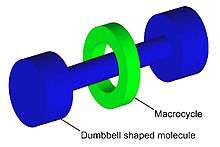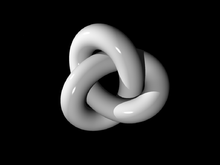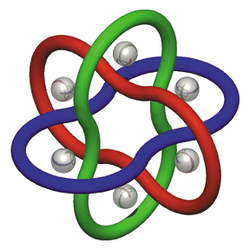Mechanically interlocked molecular architectures
Mechanically interlocked molecular architectures (MIMAs) are molecules that are connected as a consequence of their topology. This connection of molecules is analogous to keys on a key chain loop. The keys are not directly connected to the key chain loop but they cannot be separated without breaking the loop. On the molecular level the interlocked molecules cannot be separated without the breaking of the covalent bonds that comprise the conjoined molecules, this is referred to as a mechanical bond. Examples of mechanically interlocked molecular architectures include catenanes, rotaxanes, molecular knots, and molecular Borromean rings. Work in this area was recognized with the 2016 Nobel Prize in Chemistry to Bernard L. Feringa, Jean-Pierre Sauvage, and J. Fraser Stoddart.[1][2][3][4]
The synthesis of such entangled architectures has been made efficient by combining supramolecular chemistry with traditional covalent synthesis, however mechanically interlocked molecular architectures have properties that differ from both "supramolecular assemblies" and "covalently bonded molecules". The terminology "mechanical bond" has been coined to describe the connection between the components of mechanically interlocked molecular architectures. Although research into mechanically interlocked molecular architectures is primarily focused on artificial compounds, many examples have been found in biological systems including: cystine knots, cyclotides or lasso-peptides such as microcin J25 which are protein, and a variety of peptides.
Mechanical bonding and chemical reactivity
The introduction of a mechanical bond alters the chemistry of the sub components of rotaxanes and catenanes. Steric hindrance of reactive functionalities is increased and the strength of non-covalent interactions between the components are altered.[5]
Mechanical bonding effects on non-covalent interactions
The strength of non-covalent interactions in a mechanically interlocked molecular architecture increases as compared to the non-mechanically bonded analogues. This increased strength is demonstrated by the necessity of harsher conditions to remove a metal template ion from catenanes as opposed to their non-mechanically bonded analogues. This effect is referred to as the "catenand effect".[6][7] This increase in strength of non-covalent interactions is attributed to the loss of degrees of freedom upon the formation of a mechanical bond. The increase in strength of non-covalent interactions is more pronounced on smaller interlocked systems, where more degrees of freedom are lost, as compared to larger mechanically interlocked systems where the change in degrees of freedom is lower. Therefore if the ring in a rotaxane is made smaller the strength of non-covalent interactions increases, the same effect is observed if the thread is made smaller as well.[8]
Mechanical bonding effects on chemical reactivity
The mechanical bond can reduce the kinetic reactivity of the products, this is ascribed to the increased steric hindrance. Because of this effect hydrogenation of an alkene on the thread of a rotaxane is significantly slower as compared to the equivalent non interlocked thread.[9] This effect has allowed for the isolation of otherwise reactive intermediates.
The ability to alter reactivity without altering covalent structure has led to MIMAs being investigated for a number of technological applications.
Applications of mechanical bonding in controlling chemical reactivity
The ability for a mechanical bond to reduce reactivity and hence prevent unwanted reactions has been exploited in a number of areas. One of the earliest applications was in the protection of organic dyes from environmental degradation.
Examples
References
- ↑ Browne, Wesley R.; Feringa, Ben L. (2006). "Making molecular machines work". Nature Nanotechnology. 1: 25–35. Bibcode:2006NatNa...1...25B. doi:10.1038/nnano.2006.45.
- ↑ Stoddart, J. F. (2009). "The chemistry of the mechanical bond". Chem. Soc. Rev. 38: 1802–1820. doi:10.1039/b819333a.
- ↑ Coskun, A.; Banaszak, M.; Astumian, R. D.; Stoddart, J. F.; Grzybowski, B. A. (2012). "Great expectations: can artificial molecular machines deliver on their promise?". Chem. Soc. Rev. 41 (1): 19–30. doi:10.1039/C1CS15262A.
- ↑ Durola, Fabien; Heitz, Valerie; Reviriego, Felipe; Roche, Cecile; Sauvage, Jean-Pierre; Sour, Angelique; Trolez, Yann (2014). "Cyclic [4]Rotaxanes Containing Two Parallel Porphyrinic Plates: Toward Switchable Molecular Receptors and Compressors". Accounts of Chemical Research. 47 (2): 633–645. doi:10.1021/ar4002153.
- ↑ Neal, Edward A.; Goldup, Stephen M. (2014-04-22). "Chemical consequences of mechanical bonding in catenanes and rotaxanes: isomerism, modification, catalysis and molecular machines for synthesis". Chemical Communications. 50 (40): 5128. doi:10.1039/c3cc47842d. ISSN 1364-548X.
- ↑ Albrecht-Gary, Anne Marie; Saad, Zeinab; Dietrich-Buchecker, Christiane O.; Sauvage, Jean Pierre (1985-05-01). "Interlocked macrocyclic ligands: a kinetic catenand effect in copper(I) complexes". Journal of the American Chemical Society. 107 (11): 3205–3209. doi:10.1021/ja00297a028. ISSN 0002-7863.
- ↑ Stoddart, J. Fraser; Bruns, Carson J (2016). The Nature of the Mechanical Bond: From Molecules to Machines. Wiley. p. 90. ISBN 978-1-119-04400-0.
- ↑ Lahlali, Hicham; Jobe, Kajally; Watkinson, Michael; Goldup, Stephen M. (2011-04-26). "Macrocycle Size Matters: "Small" Functionalized Rotaxanes in Excellent Yield Using the CuAAC Active Template Approach". Angewandte Chemie International Edition. 50 (18): 4151–4155. doi:10.1002/anie.201100415. ISSN 1521-3773. PMID 21462287.
- ↑ Parham, Amir Hossain; Windisch, Björna; Vögtle, Fritz (1999-05-01). "Chemical Reactions in the Axle of Rotaxanes – Steric Hindrance by the Wheel". European Journal of Organic Chemistry. 1999 (5): 1233–1238. doi:10.1002/(SICI)1099-0690(199905)1999:53.0.CO;2-Q. ISSN 1099-0690.
Further reading
- G. A. Breault, C. A. Hunter and P. C. Mayers (1999). "Supramolecular topology". Tetrahedron. 55 (17): 5265–5293. doi:10.1016/S0040-4020(99)00282-3.



